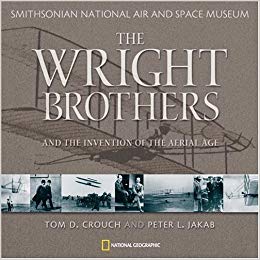Orville Wright
Listen to the Recess! Clip
| Author | Rita Smith |
| Air Date | 8/19/2002 |

Orville Wright Transcript
Even as a young child, Orville was interested in tinkering and trying new things. On the morning of his fifth birthday, his father brought him a special present. It was a top, but the strangest-looking top Orville had ever seen. It didn’t just sit on a flat surface and spin. It was a gyroscope, with a spindle that pierced a piece of lead a little larger and thicker than a silver dollar. Around the lead and the spindle were two heavy metal bands. The family played with the toy a bit, spinning the top on the point of a pencil, and “walking” it along a string. When the older boys and father went off to work and and Wilbur left for school, Orville took the top and headed for the workshop behind the house. He wanted to see if the top would spin if the metal bands were removed, so he dismantled them with a hatchet and screwdriver. In the process, he cracked the lead disk, ruining his birthday present, but his parents weren’t angry with him. “It was born in him to see how things were made,” his mother said. “My father did it all his life and Orvy is exactly like him.”1
When Wilbur was seventeen he found work in a machine shop. He wanted to learn all about machinery, because he wanted to invent things. Orville wanted to invent things too, but he couldn’t think of anything. This worried him. Why hadn’t he thought of something? He talked to his mother about it. “I’m thirteen,” he said, “I ought to be making something.”2
“You can’t make yourself invent,” his mother responded, “you just get an idea from a story someone tells, or from something someone does or needs, and suddenly an idea pops into your head.”
About a week later a neighbor who brought the Wrights butter and eggs, brought only butter. “Rats have been eating my eggs,” he explained. The farmer had tried setting a trap, but the rats got smart and avoided the trap. “You have to get a trap that doesn’t look like a trap,” suggested young Orville. “I’ll invent one and make it for you.” The trap he came up with caught 50 rats the first week. The farmer happily gave him $5 and Orville, at thirteen, was now a paid inventor. He continued to tinker, to try new things, and, as we all know, it eventually led to the beach at Kitty Hawk, North Carolina, in 1903 and the flying machine that was the beginning of aviation.
1 Stevenson, p. 21.
2 Ibid, p. 155.
Sources:
Charnley, Mitchell V. The Boys’ Life of The Wright Brothers. New York: Harper & Brothers, 1928.
Stevenson, Augusta. Wilbur and Orville Wright: Boys with Wings. Indianapolis: Bobbs-Merrill Company, 1959.